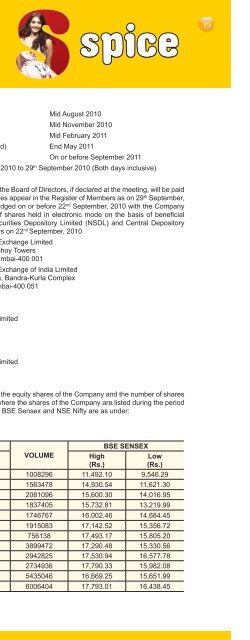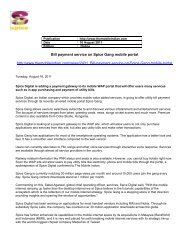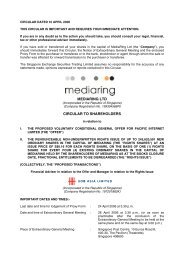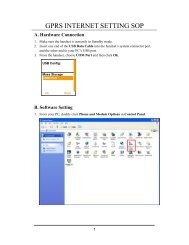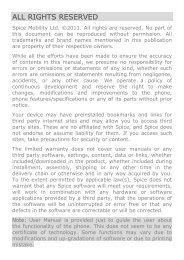Create successful ePaper yourself
Turn your PDF publications into a flip-book with our unique Google optimized e-Paper software.
<strong>Spice</strong> <strong>Mobility</strong> Limited (formerly <strong>Spice</strong> Mobiles Limited)<br />
Schedule 24<br />
Notes to Accounts<br />
(ii) Conversion<br />
Foreign currency monetary items are reported using the closing rate. Non–monetary items which are carried in terms of<br />
historical cost denominated in a foreign currency are reported using the exchange rate at the date of the transaction.<br />
(iii) Exchange Differences<br />
Exchange differences arising on the settlement of monetary items or on reporting Company’s monetary items at rates<br />
different from those at which they were initially recorded during the year or reported in previous fi nancial statements, are<br />
recognised as income or as expenses in the year in which they arise.<br />
(iv) Forward exchange contracts not intended for trading or speculation purposes<br />
The premium or discount arising at the inception of forward exchange contracts is amortised as expense or income over<br />
the life of the contract. Exchange differences on such contracts are recognised in the statement of profi t and loss in<br />
the year in which the exchange rates change. Any profi t or loss arising on cancellation or renewal of forward exchange<br />
contract is recognised as income or as expense for the year.<br />
l) Retirement and other employee benefi ts<br />
(i) Provident fund is a defi ned benefi t obligation. The Company has a private provident fund trust to whom provident fund<br />
contributions are made as and when due.<br />
(ii) Gratuity liability is a defi ned benefi t obligation and is provided for on the basis of an actuarial valuation on projected unit<br />
credit method made at the end of each fi nancial year / period. The liability as at the year / period end represents the<br />
difference between the actuarial valuation of the gratuity liability of continuing employees and the fair value of the plan<br />
assets with the Life Insurance Corporation of India (LIC) as at the end of the year / period.<br />
(iii) Short term compensated absences are provided for based on estimates. Long term compensated absences are provided<br />
for based on actuarial valuation. The actuarial valuation is done as per projected unit credit method.<br />
(iv) Actuarial gains/losses are immediately taken to the Profi t and Loss Account and are not deferred.<br />
m) Income Taxes<br />
Tax expense comprises of current and deferred tax. Current income tax is measured at the amount expected to be paid to<br />
the tax authorities in accordance with the Indian Income Tax Act, 1961. Deferred income taxes refl ect the impact of current<br />
year’s timing differences between taxable income and accounting income for the year and reversal of timing differences of<br />
earlier years / period. Deferred tax is measured based on the tax rates and the tax laws enacted or substantively enacted<br />
at the balance sheet date. Deferred tax assets and deferred tax liabilities are offset, if a legally enforceable right exists to<br />
set off current tax assets against current tax liabilities and the deferred tax assets and deferred tax liabilities relate to the<br />
taxes on income levied by same governing taxation laws. Deferred tax assets are recognised only to the extent that there<br />
is reasonable certainty that suffi cient future taxable income will be available against which such deferred tax assets can be<br />
realised. In situations where the Company has unabsorbed depreciation or carry forward of tax losses, all deferred tax assets<br />
are recognised only if there is virtual certainty supported by convincing evidence that such deferred tax assets can be realised<br />
against future taxable profi ts. At each balance sheet date, the Company reassesses unrecognised deferred tax assets. It<br />
recognises unrecognised deferred tax assets to the extent that it has become reasonably or virtually certain as the case may<br />
be, that suffi cient future taxable income will be available against which such deferred tax assets can be realised.<br />
The carrying amount of deferred tax assets are reviewed at each balance sheet date. The Company writes–down the carrying<br />
amount of a deferred tax asset to the extent that it is no longer reasonably certain or virtually certain, as the case may be, that<br />
suffi cient future taxable income will be available against which deferred tax asset can be realised. Any such write–down is<br />
reversed to the extent that it becomes reasonably certain or virtually certain, as the case may be, that suffi cient future taxable<br />
income will be available.<br />
n) Earnings Per Share<br />
Basic earnings per share are calculated by dividing the net profi t or loss for the year / period attributable to equity shareholders<br />
by the weighted average number of equity shares outstanding during the year / period.<br />
For the purpose of calculating diluted earnings per share, the net profi t or loss for the year / period attributable to equity<br />
shareholders and the weighted average number of shares outstanding during the year / period are adjusted for the effects of<br />
all dilutive potential equity shares.<br />
39


